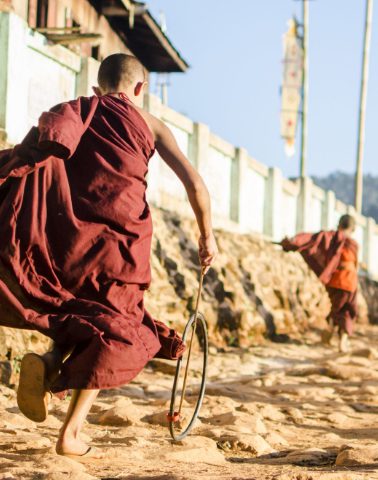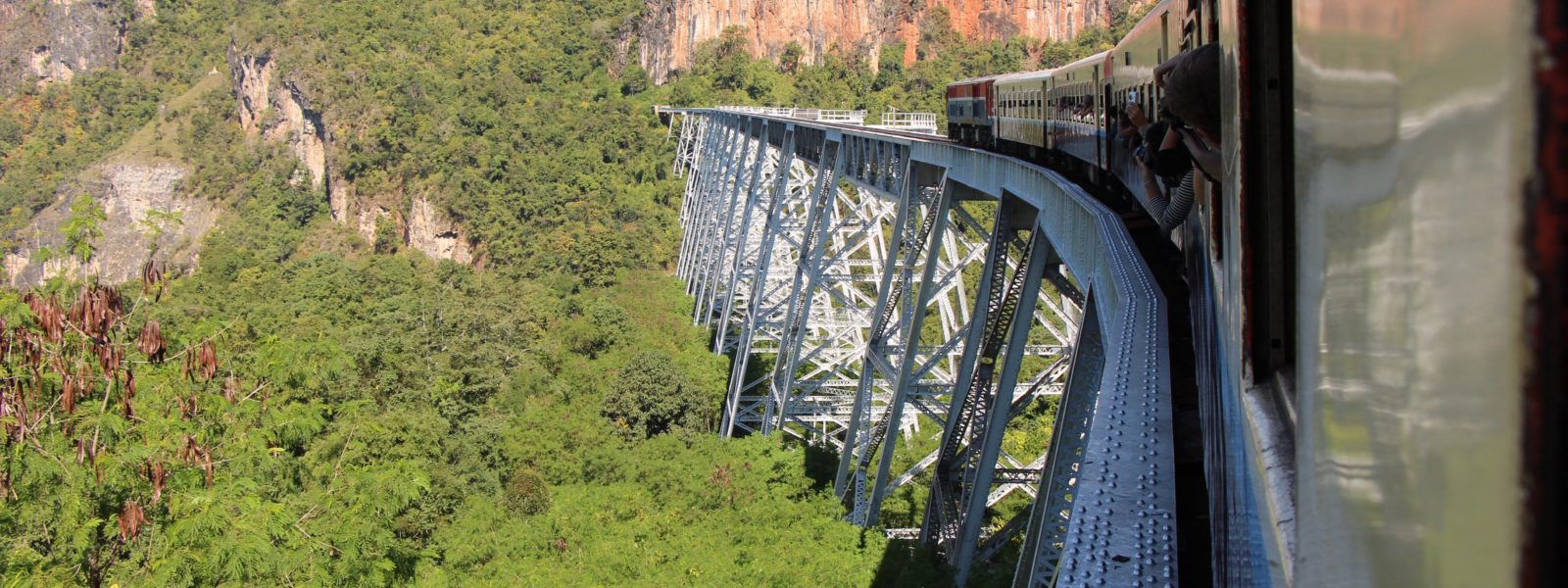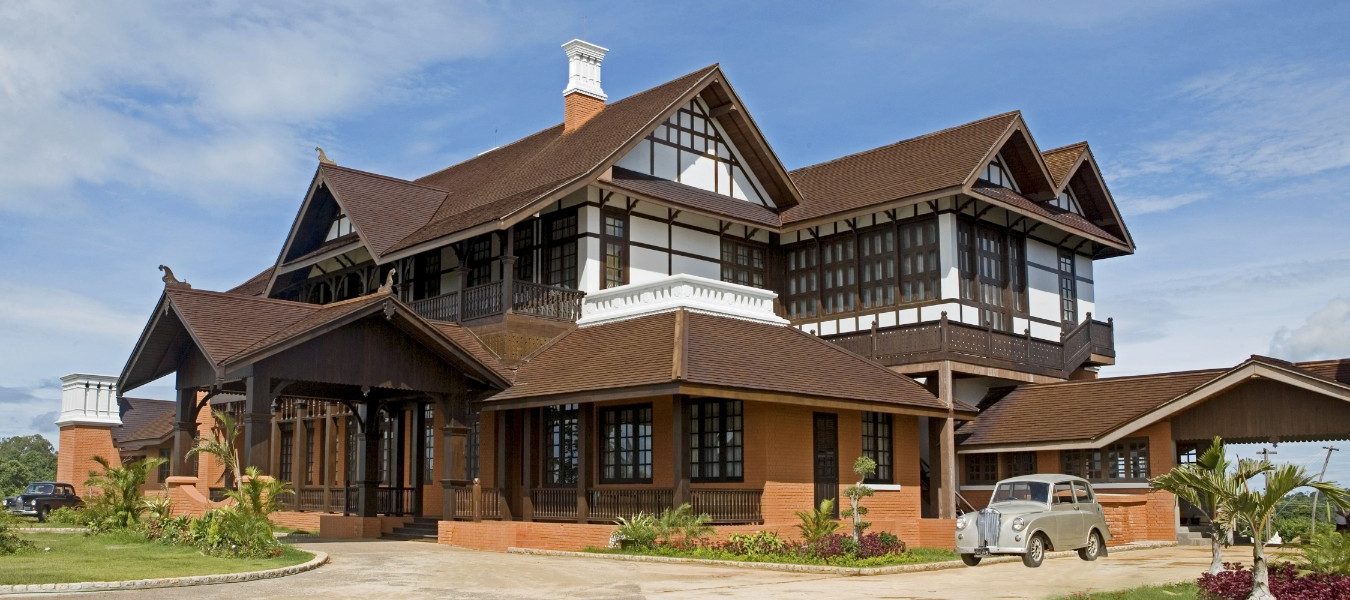
Subscribe to our mailing list
We are still here! Let us send you tips for travelling through Myanmar and stories from the road …
The most thrilling way to reach the town is by boarding a pickup truck on Mandalay’s 26th Street, answering the calls of ‘Maymyo! Maymyo!’ bellowed out by a man swinging from the back.
However to ensure an early arrival in Pyin Oo Lwin, one may choose instead to rise at sparrow-fart to catch the train which departs from Mandalay Station at around 4.45 AM each morning. Lumbering up through the hills the train chugs along for over three hours, halting to stop to pick up passengers with their produce as well as reproachfully mooing cows.
It is a far cry from the luxury train travel in oriental travelogues of times past and yet was not too slummy for the travel writer Paul Theroux to give it a go in the 1970s. In his book The Great Railway Bazaar, Theroux enthusiastically recounts looking out the window of the train while Burma washed with a ‘spirited soapy violence … women squat in conspiratorial groups at bubbly streams’ while children ‘totter in rock pools’. In the heat of the heady romance of a Myanmar morning, Theroux turns Kipling-esque as he sees young ladies ‘chastely covered by sarongs […] dump buckets of water over their heads’ and considers leaping out of the train to propose marriage.

If you find that you are taken over by a similar urge try to sit tight, for finer pleasures are to come as the train begins to climb up impossibly through the pine trees and past the stupas of gold-tipped pagodas emerging from the thick green foliage. ‘Hardier, muddier’ people appear between the towns of Mandalay and Pyin Oo Lwin and stocky women who come up to the train windows with large trays of food poised on their heads for breakfast: noodles, nuts, and sparrows fried-whole [‘sagali kyaw’] – crunchy, but not at all bad.
Pyin Oo Lwin is Myanmar’s City of Flowers and as the train nears the town you will begin to see a riot of exuberant petal and pollen being sorted, packed and prepared for transportation throughout the country. Those keen to see more of the Pyin Oo Lwin flowers can jump aboard a horse-led carriage upon arrival at the town’s station (ETA 08.30am) and ask to be taken to December Garden. Here it is possible to spend a few hours amongst the fields of flowers, picking and pruning to your heart’s content. In the winter season (November – February) punters will be able to see and explore the strawberry fields too.
Alternatively, after disembarking at the train station make your way to the Shan Market. Shan State is only 171 kilometres to the east of Pyin Oo Lwin. The Shan people are of ‘Tai’ ethnicity, sharing much of their culture with their brothers over the border in Thailand and Laos. Their cuisine is particularly tasty and throughout Myanmar ‘Shan noodles’ are a firm favourite. In Pyin Oo Lwin’s Shan Market we recommend this for breakfast along with a seasonal milkshake.
Once you have eaten you can explore the market where mouth-watering vegetables are laid throughout adorned with sprigs and twirls of flower and petal. In the winter months the flower mahonia is prodigiously used and its strong, sweet scent fills the marketplace. Clothes, embroidery and the ubiquitous Shan tote bags are on sale in the covered part of the market too. At the ‘Liquor Corner’ one can buy wine from the Aythaya Winery, Myanmar’s first, situated not far from Inle Lake.
Towards the north of the town on the Circular Road and not far from the Shan Market, is the Purcell Tower which is said to chime like Big Ben on the hour. The clocktower is one of the many colonial buildings of Pyin Oo Lwin. The town was established in 1886 as a hill station for British officers by Colonel May of the 5th Bengal Regiment. The British called the town ‘Maymyo’ or ‘May Town.’

The British managed to make it a small piece of England with houses named Ridge View and The Pines. Today nicknamed ‘Little England’, Pyin Oo Lwin is often regarded as overly British-scented and not very Myanmar at all, encouraging some visitors to find it a damp disappointment; the prolonged English drizzle does not help to endear.
Arriving in the 1990s, the journalist Andrew Marshall wrote that the mock-Tudor facades and strategic privet-hedges – ‘middle-class dream homes rising from the jungles of South-East Asia’ – had the feel of a deserted museum.
Marshall goes on to write that when the town was first being built the wife of one officer, Beth Ellis, would cycle along the brand new Circular Road daydreaming of ravenous tigers and gangs of merciless bandits watching her from the trees and she would feel sorry for ‘this poor new road, wandering aimlessly in the jungle, leading nowhere and used by no one.’
In time, the British managed to bring home comforts up the hill from Mandalay, as Marshall puts it,
… hacking from the wilderness a golf course, rugby pitches and, with the help of Turkish prisoners of war, a botanical garden – while all around the jungle frothed and seethed, waiting for a chance to invade again.
The botanical gardens remain and we recommend you head over to them directly after breakfast.
Rechristened the ‘Kandawgyi Gardens’, they were commissioned by the former Governor of Burma Sir Harcourt Butler, designed by Alex Rodger of the Forest Office in 1915, based upon the design of Kew Gardens just outside London.
Since the British left, the garden has been spiced up. There is now a Takin enclosure, three museums (one for petrified wood, another for fossils, a third for butterflies), a watch tower and the compulsory pagoda in the middle of the lake – which, surprisingly for Myanmar, appears slightly incongruous. One of the highlights of the gardens is the walk-in aviary where visitors can be amongst birds such as Rufous-Necked Hornbills, Golden Pheasants and Indian Griffon Vultures. Outside the enclosure monkeys whoop, their intimidatingly large arms swinging not too far over ahead, reminding one that the jungle is not entirely subdued.
like a mansion in Newport or Eastbourne, with porches and gables and over the door a neatly pruned trellis arch of ivy. … the floors gleaming with polish, the bannisters shining.
The garden, like Pyin Oo Lwin in general, takes itself rather seriously, referring to itself as a ‘Natural Monument’ and imposing a ban on ‘spitting Betel nut chew’ and ball games. Chelsea Tractors roll slowly into the park and out file neat families in their tidiest best; summer hats on show, spring dresses, chinos, sweater-vests and hair smartly combed to one side. If it wasn’t for the selfie-sticks, if one were to squint, the scene could look remarkably Victorian, minus the bandstand and Punch & Judy show.
The gardens are delightful and a good few hours should be set aside to explore them in their entirety at your own leisure.
For lunch we recommend Hlaing Cafe on Gurkha Road, a restaurant run by a Gurkha family, descendants of the imperial troops that played a prominent role in bringing Upper Burma into the bosom of the British Empire.
Energetic visitors may wish to spend the afternoon at either the Anisakan or Pwe Kauk waterfalls just outside of the town; however we would recommend following Beth Ellis’s example and spend this first afternoon exploring the town on bicycle.
Despite being used as a military base for both sides, Maymyo suffered little of the destruction during World War Two that Mandalay did. Under Japanese occupation, Maymyo became a lot of fun for those in charge. General Mutaguchi took control of 15 Army in March 1943 and with the Allied troops retreating over the Indian border set up his HQ here. In Maymyo he remained for the duration of the Burma campaign hosting lavish banquets whenever there was good news from the front or when reports of significance arrived. They set up a ‘Seimeiso’ in the town within which each officer had his own geisha. The ‘Seimeiso’ was open every night and would serve pure sake even when sake was almost unobtainable in Tokyo.
Whereas Maymyo was largely a pleasure town for the Japanese, the British to the contrary used it to keep their men from getting into trouble in Mandalay. The kernel of Maymyo was Candacraig, a glorious red-brick ‘raj chummery’. Candacraig is situated just off the Circular Road to the east of the town and can be easily reached by bicycle. Here unmarried officers of the Bombay-Burma Trading Company were sent to keep away from the sensual delights of Mandalay and instead exert themselves at rugger and polo.
Candacraig was still in good shape when Theroux visited in the ‘70s, described as ‘like a mansion in Newport or Eastbourne, with porches and gables and over the door a neatly pruned trellis arch of ivy. … the floors gleaming with polish, the bannisters shining.’
Today the Candacraig Hotel is often changing hands and is currently, once again, under renovation. Because most locals believe it to be haunted and because most of the visitors to Pyin Oo Lwin are domestic tourists, the Candacraig does not do a roaring trade. Nonetheless, if open we would certainly recommend, if not a meal, a stiff Gin & Tonic at the bar.
Hotel Pyin Oo Lwin (bottom right)
A day in Pyin Oo Lwin tracing the ghosts of its former residence can indeed give the town the ‘museum’ feel that Marshall experienced. The Indian Restaurant The Taj situated on the banks of Pyin Oo Lwin’s small lake serves fantastic food but rarely has enough clientele to give it much atmosphere. Therefore to end 24 hours in Pyin Oo Lwin it may well be a more enjoyable option to try one of the more local spots frequented by Myanmar’s growing middle-class and the many soldiers that call the town home.
As at other former British Hill Stations, the Burmese military, the Tatmadaw, have a base at Pyin Oo Lwin. Here is the Defence Services Academy, Myanmar’s equivalent to Sandhurst. Indeed, the pretty horse carriages that trot merrily around the town are more commonly filled with grim-faced cadets than frivolous tourists. To the north of the town are large golden statues of heroic Burmese warriors, another tell-tale sign that this is a town in the grips of the army. One may feel that although Pyin Oo Lwin does not have the flavour of the rest of Myanmar, it is still very nationalistic.
In this sense, perhaps not much has changed.
Visiting twenty years before Theroux and forty before Marshall, the writer Norman Lewis arrived at Maymyo during the chaotic tenure of U Nu, Burma’s first prime minister post independence, when government forces were at fierce battle with a score of would-be rulers including ‘Red Communists’, ‘White Communists’, armed ethnic groups and opportunistic bandits.
In this furore, true to its reputation Maymyo remained an isolated pocket of calm. Lewis, who came to Burma for excitement was not impressed and described it as: ‘austere, sporting and contemplative. Maymyo was very clean, hard-working, hard-playing, exaggeratedly national and slightly dull.’ He compared it unfavourably to Dalat in Indo-China. Where in the latter the French had ‘tinkered with bamboo and carved wood and produced an acceptable pastiche … Frenchified of course, but still of recognisably oriental origin’, in Maymyo there was no compromise.
Lewis writes:
… beyond the show of sweet peas, the jungle was kept in check behind an iron railing. The jungle was not particularly exuberant, and had been made to look rather like a gentleman’s sporting estate in the Home Counties, by the cutting through it of numerous walks and avenues.
The only thing of exotic Burma that passed over the boundary was the odd squawking jungle fowl, a ‘decorative adjunkt’ to the demesne.
Pyin Oo Lwin may not be very like Myanmar at all. However, it is like nowhere else in Myanmar; and for that reason, if nothing else, it is worth 24 hours.